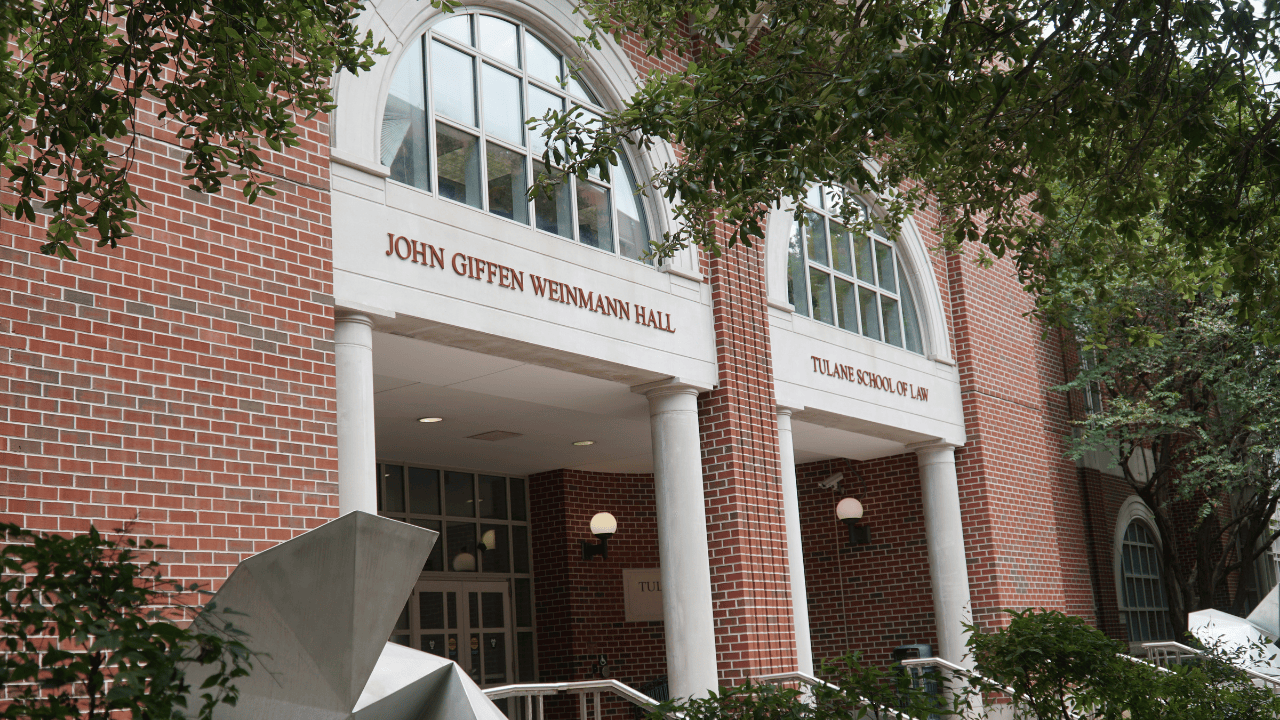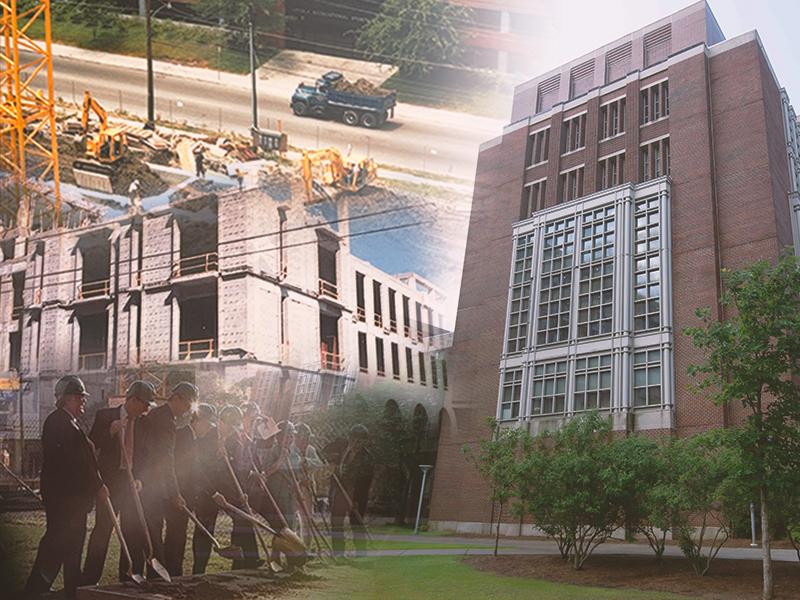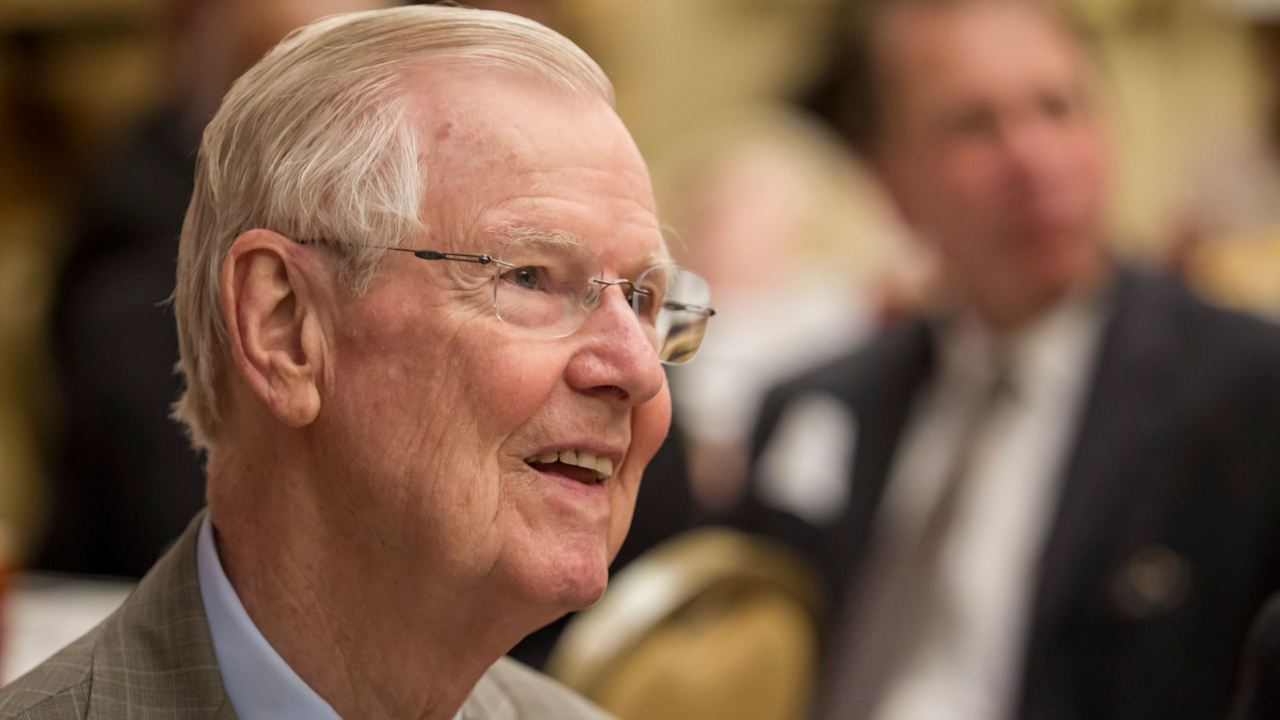Weinmann Hall Marks 30 Years as the Heart of Tulane Law
When Tulane Law students entered John Giffen Weinmann Hall for the first time in the fall of 1995, it marked the beginning of a new era. The gleaming structure, the largest on Tulane University’s Uptown campus at the time, symbolized the school’s growth and its commitment to modern legal education.
Thirty years later, Weinmann Hall remains the center of life at Tulane Law School.
“As a Tulane Law student, Jones Hall was where I first learned the law and built the friendships and professional experiences that shaped my career,” said law Vice Dean Stacy Seicshnaydre (L’92). “Now, as a member of the faculty in Weinmann Hall, I can see how moving into the new building positioned Tulane Law for the future by modernizing our facilities and bringing all our programs under one roof.”
The vision for that transformation came from then-Dean John Kramer and alumnus and former U.S. Ambassador John Giffen Weinmann (A&S '50, L'52), whose name the building bears. Together, they led a project that would redefine Tulane Law’s footprint and give its students and faculty a state-of-the-art home.
“Leaders like John Kramer and Ambassador Weinmann, who had the foresight to build a new home for Tulane Law in the early 1990s, set the foundation for everything we are today,” said Dean Marcilynn Burke. “Their vision gave us a place where scholarship, teaching and community could thrive together. Because of their boldness, Tulane Law has been able to prepare generations of lawyers for leadership and service, and their legacy continues to shape our future success.”
Weinmann Hall’s Arrival
Weinmann Hall is the most recent home of Tulane Law. Established in 1847, the law school had occupied several buildings across New Orleans, with each move reflecting its growth. Classes first met in a federal courtroom in the U.S. Customs House on Canal Street, then later in various downtown buildings before relocating to the Uptown campus in the early 1900s.
By 1928, the law school was housed in Dinwiddie Hall, and in 1968 it moved again—this time to Joseph Merrick Jones Hall, where it would stay for nearly three decades. But by the late 1980s, Jones Hall could no longer meet the needs of a growing student body.
“The class size expanded to 300 to 350 students by the late 1980s,” recalled Professor Catherine Hancock, who joined the faculty in 1976. “Jones Hall was crowded for so many years, with none of the ordinary amenities you would expect to see in a law school used by 1,000-plus people.”
Hancock remembered the thin walls between classrooms. “One day, all the students in my class could hear waves of laughter coming through the wall from Professor Friedman’s classroom next door,” she said, laughing. “It turned out that he was juggling—a teaching technique that I applaud—but it gives you a sense of how little privacy or comfort existed for either students or teachers in Jones Hall.”
The Vision of Weinmann
The need for space and modernization drove Dean Kramer and Ambassador Weinmann to imagine something new: a building that could match Tulane Law’s ambitions and global reach. Under their leadership, and with the support of Weinmann and his wife, Virginia, the dream became reality in 1995.
Weinmann, who earned both his bachelor’s and law degrees from Tulane in the early 1950s, was a successful attorney, businessman, philanthropist, and diplomat. He served as U.S. Ambassador to Finland from 1989 to 1991 and later as the White House Chief of Protocol under President George H.W. Bush.
At Tulane, Weinmann was a tireless supporter of the law school. He helped establish the Eason-Weinmann Center for International and Comparative Law, served on the Dean’s Advisory Board, and chaired Tulane’s Board of Administrators. His lifelong commitment to the university earned him Tulane’s Distinguished Alumnus Award in 2002 and induction into the inaugural Tulane Law School Hall of Fame in 2013. He died in 2016, but his wife and family continue to support the law school, attending the annual Eason-Weinmann Lecture each year.
A Building Designed for Connection
The construction of Weinmann Hall blended tradition with innovation. Its New Orleans-inspired architecture featured two courtyards that drew light into the building, while classrooms, offices, and clinics were arranged to foster daily interaction between faculty and students.
For the first time, Tulane’s law clinics—along with seminar rooms, breakout spaces, study areas, and courtroom auditoriums—were brought under one roof. The law library, enhanced with new technology and the statue of Nathan Hale carried over from Jones Hall, became both a scholarly hub and a symbolic centerpiece.
Faculty and students still remember their first impressions. “The students were so stunned by the contrast with Jones Hall that they called their new home ‘the Starship Enterprise,’” Hancock said.
Tom Lane (L’91), who had studied at Jones, recalled that Weinmann Hall had "room to sit, talk, and exhale—properly equipped classrooms and a courtyard.”
The difference was immediate. Weinmann Hall’s modern facilities elevated both teaching and student life, hosting conferences, lectures, and visiting dignitaries that enriched the school’s academic community.
A Legacy for the Future
In the decades since its opening, Weinmann Hall has lived up to its promise. It has weathered hurricanes, hosted generations of law students, and served as the stage for pivotal moments in Tulane Law’s history, from major academic conferences to the 2017 celebration of Ambassador Weinmann’s life.
But with time comes change, and the building’s next chapter is already under discussion. Administrators are exploring ways to update Weinmann Hall to meet evolving needs—enhancing technology, improving sustainability, and maintaining a space that fosters collaboration and innovation in legal education.
“I’m looking forward to working with our dynamic and dedicated alumni,” Burke said. “We are prepared for today’s needs and always looking to the future.”
Weinmann Hall’s story, Burke added, is about more than bricks and mortar. It reflects Tulane Law’s enduring values: scholarship, advocacy, and community. For 30 years, the building has been the backdrop to generations of legal careers—and the foundation for many more to come.



